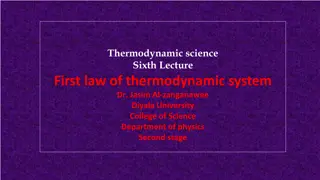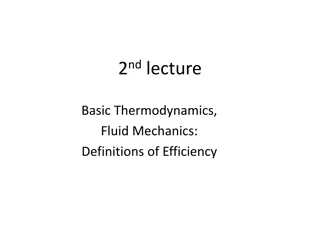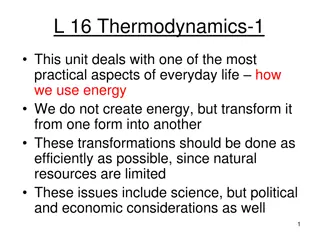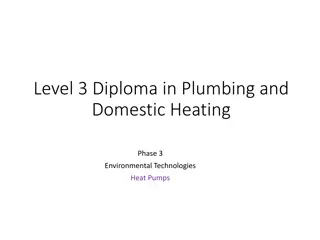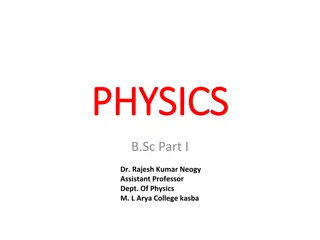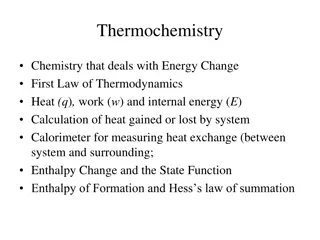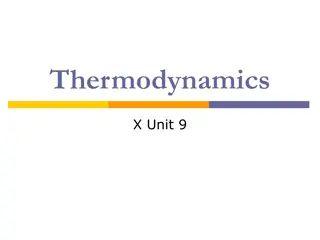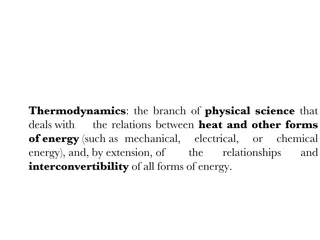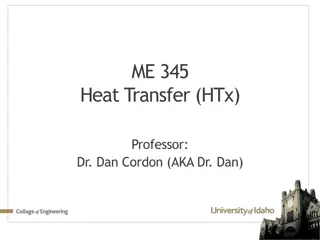Understanding Thermodynamics: Energy and Heat
Explore the fundamental concepts of thermodynamics, including the conservation of energy, entropy, heat transfer, and the relationship between temperature and kinetic energy. Discover how energy transforms in natural events, the laws governing thermodynamics, and the role of heat in the motion of particles. Gain insights into the properties of heat, kinetic energy, and temperature through engaging visuals and explanations.
Download Presentation

Please find below an Image/Link to download the presentation.
The content on the website is provided AS IS for your information and personal use only. It may not be sold, licensed, or shared on other websites without obtaining consent from the author. Download presentation by click this link. If you encounter any issues during the download, it is possible that the publisher has removed the file from their server.
E N D
Presentation Transcript
Thermodynamics ~Energy
Intro Most natural events involve a decrease in total energy and an increase in disorder. The energy that was lost was converted to heat. An increase in energy/motion decreases the overall order (organization) of the system. Energy is never created nor destroyed it simply changes form.
Entropy and heat Entropy is a measure of randomness or disorder of a system. Entropy gets the symbol S Heat energy is the kinetic energy of an object. The more motion in an object, the more random it becomes.
Thermodynamics Thermo heat; dynamic- change or motion. Thermodynamics- conversion of heat energy (into other forms or objects). 1stLaw of Thermodynamics- the amount of energy in the universe is constant. Law of conservation of energy. 2ndLaw of Thermodynamics- Spontaneous processes, ones that happen on their own, involve an increase in entropy. Entropy in the universe is always increasing.
Heat ~is the total thermal energy of an object. Like all energy, heat is measured in joules (J) The terms hot, warm, cool and cold are always relative. Heat is only noticed when there is a transfer from one object to another. Heat always flows from hot to cold. This due to the 2ndlaw of thermodynamics.
Kinetic Energy All atoms/molecules in any object are moving. The faster they are moving the more kinetic energy an object has. The heat energy or thermal energy is the total (sum of) kinetic energy of all particles in an object.
Temperature Temperature is a measure of the intensity of the heat energy present. This is measured by the average kinetic energy of all atoms/molecules present. In other words, it s the average amount of heat energy that will transfer. Temperature is measured in Fahrenheit, Celsius or Kelvin.
Units of Temperature Here are some common temperatures in the different scales COMMON TEMPERATURES F C K freezing point of water room temperature (comfortable) human body temperature Boiling point of water 32 68 98.6 37 212 0 20 273 293 310 373 100
Converting between temperature units Kelvin = 273 + Celsius (9/5 Celsius) + 32 = Fahrenheit Convert 65 F to C and K 18 C, 291 K Convert 301 K to C and F 28 C, 82 F
Two objects When two objects of different temperatures are next to each other heat will transfer from the higher temperature to the lower temperature object. By the 2ndlaw of thermodynamics This is not necessarily the object with more energy. Consider a hot penny dropped into a large cup of room temperature water.
Penny and water Similar to the penny from the last lab, but we will exaggerate the size of the cup of water. The penny will have a higher temperature, intensity of heat energy, but the water will have to have more thermal energy due to the amount of water present.
Penny and water When dropped in, the penny sizzles, and the heat flows from the penny into the water. This is obvious, since you can now touch the penny. Even though the water had more total energy than the penny. This increases entropy.
Zeroth Law of Thermodynamics If object A is at thermodynamic equilibrium with object B, and object B is at thermodynamic equilibrium with object C, then object A it at thermodynamic equilibrium with object C. Thermodynamic equilibrium means they are the same temperature. This means that if there was another penny in the cup on the previous slide, you can state that both pennies will be the same temperature even if they don t touch because they will both be at thermodynamic equilibrium with the water.
First and Second Laws of Thermodynamics 1stlaw of thermodynamics, (Law of conservation of energy) the amount of energy in the universe is constant. Euniverse= 0 Energy can be neither created nor destroyed, it can only change forms. 2ndlaw of thermodynamics, in any spontaneous process, or one that happens on its own, there is always an increase in the entropy of the universe. Suniverse> 0
The Second Law/Entropy Originally, chemists thought only exothermic reaction could be spontaneous, or happen on their own. That is incorrect. Endothermic reactions can be spontaneous (photosynthesis), and not all exothermic reactions are spontaneous. What makes a reaction spontaneous is an increase in entropy.
Questions Predict whether entropy will increase or decrease for each of the following processes. 1. Solid sugar is added to water to form a solution. 2. Iodine vapor condenses on a cold surface to form crystals.
Condensation is a decrease in entropy?!?!? How can anything spontaneously (naturally) condense if it is a decrease in entropy? Water spontaneously condenses on pop cans and plants all the time!?! To answer this, you need to step back and look at the entire universe, not just the system. Sometimes parts of a universe need to be organized (or clumped together) to allow other parts of the maximum amount of disorder.
Cont. Compare how much one thing (system or surroundings) increased in entropy to how much the other thing decreased in entropy. As long as the overall change in entropy for the universe is positive, it can happen spontaneously. Back to water condensing Water doesn t condense on pop cans. Water condenses on COLD pop cans, in warm moist air. Water doesn t condense on warm pop cans in warm surrounding, or cold pop cans in a cold surrounding (fridge)
Cont. again A cold pop can in a warmer area is a state of low entropy. In order to increase the entropy of the pop can s temperature, heat needs to transfer from the surrounding area to the pop can. S = + In doing so, this forces the water vapor to condense decreasing entropy. S = - Which change is greater? Without calculations, we can conclude that the entropy increases more than it decreases for an overall positive S for the universe because this process happens spontaneously.
Universe= system + surroundings It helps to break the entropy up into the categories of universe, system and surroundings Suniverse= Ssystem+ Ssurroundings Suniv> 0, then the entropy of the universe increases and the process is spontaneous or happens on its own. If Suniv< 0, the process is not spontaneous. If Suniv= 0, then the system is at equilibrium.
Question Plants and animals grow. This is an obvious decrease in entropy. Are all living things a violation of the 2ndlaw of thermodynamics? In any living organism, large molecules are assembled from smaller ones. Is this process consistent with the second law? Yes, as long as other processes that force this to happen in the cell obtain a larger increase in entropy than the decrease in entropy by the creation of the larger molecule.
Answer Living things don t grow isolated from the universe. In order to grow, an animal must eat. What is eating? Taking large complex molecules and breaking them down to smaller molecules to release energy. This is a large increase in entropy. Again, based off observation we can say these other processes do have a larger increase in entropy because this action does happen spontaneously.
Plants Plant s don t eat. They actually do undergo cellular respiration, so in a sense they do eat , they just make their own food. In order to make their food, plants need to be next to a source to a of increasing entropy. That is the Sun. This is how all nonspontaneous reactions are forced to occur. They are placed in an environment where something else will increase in entropy.
Matter without heat energy Solids have the lowest amount of kinetic energy, however their particles still vibrate. If you cool it until molecules no longer vibrate, and we would get to a state of possible zero entropy it is theorized this occurs at -273.15oC or - 459o F or 0 K This is called absolute zero. It is when all motion stops. Scientists have made it to 0.000 000 02 K
Third Law of Thermodynamics As the temperature of a body approaches absolute zero, all processes cease and the entropy approaches a minimum value. This minimum value is almost zero, but not quite. The law continues that It is impossible for any procedure, no matter how idealized, to reduce any system to absolute zero in a finite number of steps. Laws explain what, not why.
Problems with forcing extremes Whenever you are heating something, heat is escaping somewhere. Why can t you melt steel on your stove? Natural gas flames are in the range of 1800-2000oC Steel melts around 1400oC, depending on the alloy. As it gets hotter more heat escapes to the surrounding area. You eventually reach a point where the amount of heat escaping the surrounding area equals the amount going into the substance. So it isn t getting heated anymore.
Cont. Now of course you can correct this problem by getting a hotter flame, or by better insulating the area around the steel. However, you would run into this same problem again at a higher temperature. Further corrections would be needed.
Reverse the problem Whenever you are cooling something, (removing heat, there is NO cold energy) heat is always entering from somewhere. This is why there is such difficulty getting to absolute zero. How do you stop any heat from being able to enter a substance? No one knows. Which leads us right back to the Third Law of Thermodynamics. It can t be done as a summary of all attempts so far.






